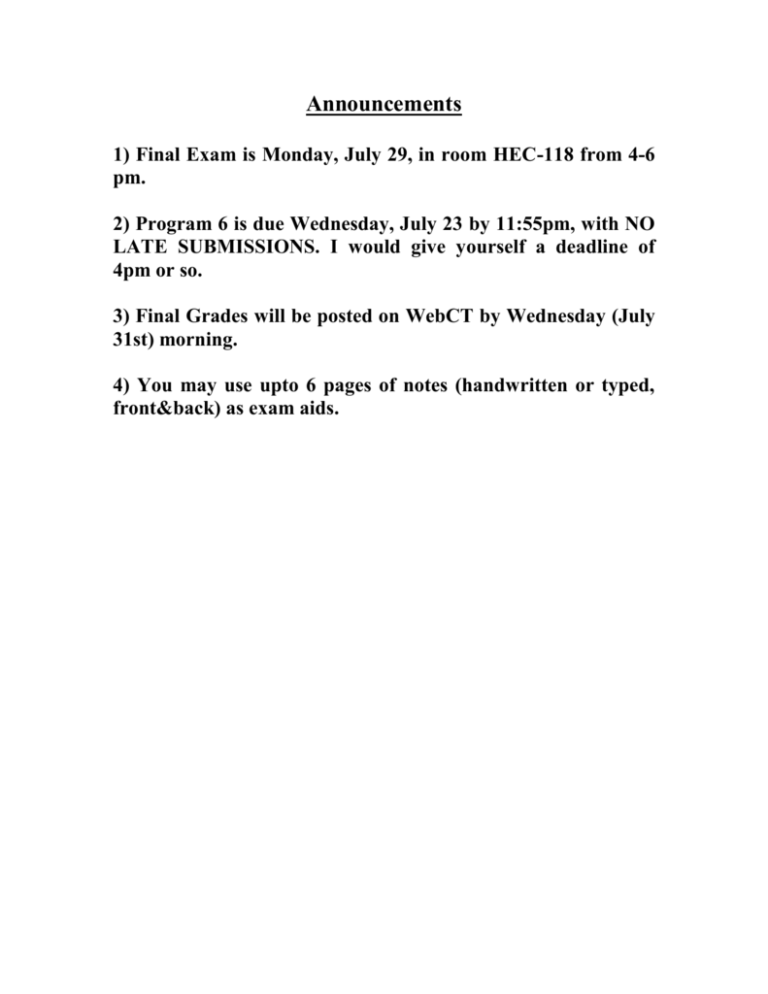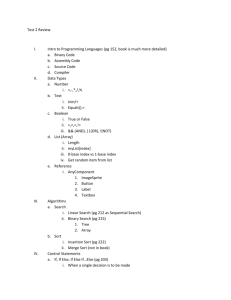Announcements
advertisement

Announcements
1) Final Exam is Monday, July 29, in room HEC-118 from 4-6
pm.
2) Program 6 is due Wednesday, July 23 by 11:55pm, with NO
LATE SUBMISSIONS. I would give yourself a deadline of
4pm or so.
3) Final Grades will be posted on WebCT by Wednesday (July
31st) morning.
4) You may use upto 6 pages of notes (handwritten or typed,
front&back) as exam aids.
Outline of Topics for the Exam
I. Basics of C
a. if
b. loops
c. functions
d. arrays
e. strings
f. other incidentals (files, etc.)
II. Mathematical Background
a. binary
b. logs and exponents
c. sums
d. Big-Oh problems
III. Pointers and Dynamic Arrays
a. how to allocate space dynamically
b. how to free space
c. how to "resize" an existing array
IV. Structs
a. how to declare structs
b. how to use pointers to structs
c. how to use arrays of structs
d. how to pass structs into functions
V. Recursion
a. Fibonacci
b. Factorial
c. Towers of Hanoi
d. Binomial Coefficients
e. Binary Search
f. Generating Permutations
VI. Algorithm Analysis
a. Average case vs. Worst case
b. Determining a Big-Oh bound
c. Use of sums, etc.
VII. Sorting
A. Bubble Sort
B. Insertion Sort
C. Selection Sort
D. Merge Sort
E. Quick Sort
VIII. Stacks
A. Array Implementation
B. Dynamically Sized Array Implementation
C. Linked List Implementation
D. Efficiency of push, pop
E. Determining the Value of Postfix Expressions
F. Converting Infix to Postfix
IX. Queues
A. Array Implementation
B. Dynamically Sized Array Implementation
C. Linked List Implementation
D. Efficiency of Enqueue and Qequeue
X. Linked Lists
A. Creating Nodes
B. Insertion
C. Searching
D. Deletion
XI. Binary Search Trees
A. Creating Nodes
B. Tree Traversals (preorder, inorder, postorder)
C. Insertion
D. Searching
E. Deletion
F. Code Tracing
XII. AVL Trees
A. Identifying nodes A, B and C
B. When to do rotations
XIII. Binary Heaps
A. percolateUp
B. percolateDown
C. Insert
D. deleteMin
E. makeHeap
F. Heap Sort
XIV. Hash Tables
A. linear probing replacement technique
B. quadratic probing replacement technique
C. linear chaining hashing
Mathematical Background
a) With respect to binary, remember the algorithm to convert
to and from binary and decimal. To go from decimal to binary,
use repeated division and mod by 2. In general, to go from base
10 to another base, use repeated division and mod by that base.
b) Make sure you know how to apply some basic log rules,
including adding and subtracting two logs, the power rule, and
that the log and exponent functions are inverses of each other.
c) You should be able to handle somes between various bounds
of a constant and a linear function.
d) To set up the Big-Oh problems given in this course, make
sure you set up a function that solves for the running time of
an algorithm and use the given information to solve for the
unknown constant.
Structs
Just make sure you can handle the various different modes in
which structs are used. (By themselves, in an array, inside of
another struct, etc.)
Recursion
I am likely to ask a recursive coding question and a recursive
tracing question.
Remember, that often, recursion fits into one of two
constructs:
1) if (!terminating condition) { do work }
2) if (terminating condition) { finish } else { do work, call rec }
However, not all recursive algorithms, follow these two
constructs. Consider the permutation algorithm. It does not
just make one recursive call or even two.
The main idea behind recursion is to take a problem of a
certain size, do some work and finish solving the problem by
solving a different version of the same problem of a smaller
size.
The toughest part is "seeing" how you can break a problem
down into a smaller recursive solution.
My favorite analogy is imagining that someone else has written
a function to solve the task already, and your job is to write a
function to solve the task at hand, but you can call the function
that someone else has written as an aid, just not with the same
parameters.
Algorithm Analysis
The key goal here is to determine the number of simple
statements that are run by a segment of code. Typically, a
summation can be set up to determine this, in terms of some
input parameter.
Linked Lists
Make sure you look at all the mechanics involved in inserting
and deleting nodes from a linked list. Also, consider slight
"twists" in the design of a linked list, like a circular list or a
doubly linked list.
The most important pieces of information dealing with linked
lists:
1) Watch out for NULL pointer errors
2) Make sure you don't "lose" the list.
3) Make sure you connect the links in the proper order.
4) Don't forget to "patch" everything up for some operation.
5) Determine when it is necessary and not necessary to use an
extra helper pointer.
6) Determine when it is necessary and not necessary for a
function to return a pointer to the beginning of the list.
Binary Search Trees
Many of the concerns necessary with linked lists translate over
to binary trees. One key point about binary trees:
Recursion is even more important/useful for binary trees than
linked lists. In particular, it's very difficult to think about how
to iteratively go through all the nodes in a binary tree, but
recursively, the code is reasonably concise and simple.
AVL Trees
All I will test upon for these is how to do rotations after
insertions and deletions. Remember the following ideas:
1) All insertions can be fixed with a single rotation.
2) Deletions may need more than one rotation to be fixed. But
all errors are propogated up the tree.
To find WHERE to do a rotation, start at the inserted node or
the parent of the deleted node, going "up" the tree, node by
node, until you find an offending node. Then perform the
appropriate rotation. From there, continue up the tree.
Binary Heaps
A binary heap is an efficient data structure to use if the main
operations that need to be handled are inserting items and
deleting the minimum item. Both tasks can be done in O(lg n)
time, where n represents the number of items stored in the
heap.
Typically, a binary heap is implemented using an array.
The key to getting a binary heap working are the subroutines
identified in class as "percolateUp" and "percolateDown".
Hash Tables
A hash table is an efficient data structure that easily allows for
inserting items and searching for items. The main problem
with hash tables is collisions, since hash functions are many-toone functions (meaning that two different input values can
hash to the same output location.) There are three ways to deal
with collisions discussed in class:
a) Linear Probing
b) Quadratic Probing
c) Linear Chaining Hashing
The first couple are reasonable so long as the table is no more
than half full. The last is most probably the best way to deal
with the issue.






